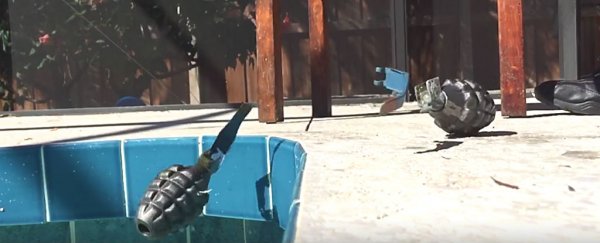Picture this: you're hanging out with your buddy, having a few beers and admiring the pair of live hand grenades you just happen to have lying around, and all of a sudden… *insert random distraction here*.
The grenades go flying, the handles come loose, and one lands on the ground, and the other in the pool. You've got zero time to decide, so do you a) take your chances on land, or b) dive into the pool and hope the water shields you from the blast? If you have no idea, don't worry, YouTube science buffs Mark Rober and BackyardScientist Kevin are here to help you with your hypothetical grenade problem.
For the purposes of this experiment, both participants end up about 4.5 metres (15 feet) away from their respective grenades, because that's about as far as you could probably get in a split-second's notice. So who gets least rekt when the grenade explodes?
Mark and Kevin each have different hypotheses to explain whether they think land or water is the safest option, and in the video above, they test out each one. But before we get to that, you need to understand exactly how a grenade works first.
Everyone knows that a grenade is basically harmless as long as you have the pin in place. Once that pin is removed, as soon as you release your grip on the grenade, the spring-loaded handle will fly off, and it's explosions time.
With the release of the handle comes a series of events inside the grenade, prompted by the firing of a spring-loaded striker that gets pushed down onto a percussion cap when the handle is dislodged. The pressure on the cap creates a fuse that detonates the explosives.
Ever wondered why grenades are always covered in a waffle pattern? As Mark explains, this bumpy pattern actually creates weak points in shell, so that's where it's going to break first when it detonates. "And since there are 40 bumps, this grenade is basically an explosion that shoots 40 bullets in all directions," he says. Yikes.
Regardless of whether you're on land or in water, your best chance against all that is to get as far as possible away from the grenade, lie down, and face your feet towards it. Amazingly, at 4.5 metres away, Mark puts his chances of getting hit by a grenade bullet at less than 1 percent.
Still not happy with a 1 percent chance of being punctured by a pellet of hot metal? Me neither, so let's hop in the pool.
Thanks to another YouTube scientist, Norwegian physicist Andreas Wahl, we know that getting shot underwater is nowhere near as dangerous as getting shot on land (but probably just as terrifying), and the same physics that saved Wahl from a nasty injury could theoretically protect Kevin from his hypothetical grenade.
As the video explains, the pressure from the water against the grenade projectiles would be so great, the projectiles would actually disintegrate before they make it anywhere near Kevin.
But this isn't the whole story, because while the grenade pellets can't touch Kevin, he'll still end up 100 percent dead for choosing to spend some time in a pool with a grenade. Why? I'll let the boys explain that with their experiments in the video above, but let's just say that 1 percent is suddenly looking like the only way to go…
Here's Andreas Wahl and his underwater gunshot experiment:
H/T: SPLOID
